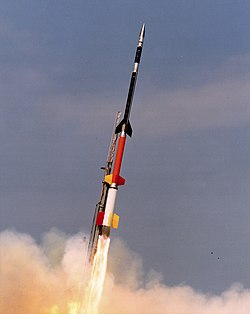
Back صاروخ تجارب Arabic Meteoroloji raket Azerbaijani Coet sonda Catalan Sondážní raketa Czech Höhenforschungsrakete German Sonda raketo Esperanto Cohete sonda Spanish Suziri-zunda Basque موشک ژرفاسنج Persian Luotainraketti Finnish

A sounding rocket or rocketsonde, sometimes called a research rocket or a suborbital rocket, is an instrument-carrying rocket designed to take measurements and perform scientific experiments during its sub-orbital flight. The rockets are often used to launch instruments from 48 to 145 km (30 to 90 miles)[1] above the surface of the Earth, the altitude generally between weather balloons and satellites; the maximum altitude for balloons is about 40 km (25 miles) and the minimum for satellites is approximately 121 km (75 miles).[2]
Due to their suborbital flight profile, sounding rockets are often much simpler than counterparts built for orbital flight.[2] Certain sounding rockets have an apogee between 1,000 and 1,500 km (620 and 930 miles), such as the Black Brant X and XII, which is the maximum apogee of their class. For certain purposes, sounding rockets may be flown to altitudes as high as 3,000 kilometers (1860 miles) to allow observing times of around 40 minutes to provide geophysical observations of the magnetosphere, ionosphere, thermosphere and mesosphere.[3]
- ^ nasa.gov NASA Sounding Rocket Program Handbook, June 2005, p. 1 (Archive link, December 2024)
- ^ a b "NASA Sounding Rocket Program Overview". NASA Sounding Rocket Program. NASA. 24 July 2006. Archived from the original on 27 November 2024. Retrieved 10 October 2006.
- ^ "High Altitude Sounding Rocket" (PDF). NASA Sounding Rocket Program. NASA. 29 September 2024. Archived from the original (PDF) on 27 November 2024. Retrieved 29 September 2024.